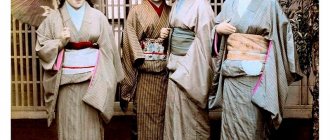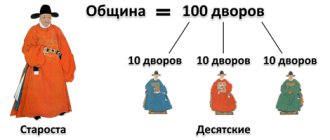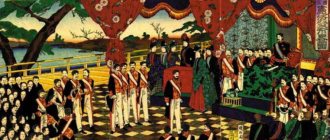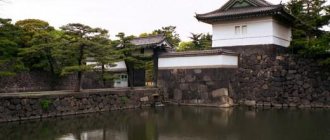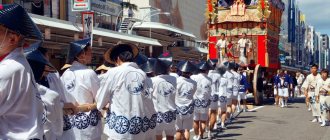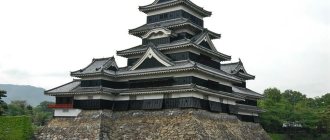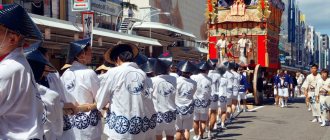Definition 1
“Taika reforms” are great changes, large-scale socio-political transformations in Japanese history; they were carried out in the 7th-8th centuries under the leadership of Prince Naka no Oe. The reforms received their name according to the motto of the Taika imperial rule.
The main goal of the Taika reforms was to transform Japan into a monarchy, creating a centralized state headed by an emperor, as in the Chinese empire under the rule of the Tang Empire.
Prerequisites
At the beginning of the 7th century, a crisis situation arose in Japan, its main reason being the struggle for the possession of dependent peasants and lands, the struggle for power over the still free community members between the rulers of Yamato and the new nobility, which was formed in the 6th-1/2 of the 7th century.
Finished works on a similar topic
- Coursework Japanese reforms Taika 460 rub.
- Abstract Japanese reforms Taika 230 rub.
- Test paper Japanese reforms Taika 210 rub.
Receive completed work or specialist advice on your educational project Find out the cost
The main prerequisite for reforms was the overthrow of the dictatorship of the Soga clan in 645 and the coming to power of the opposition, after which Kotoku was chosen as emperor. A year later, he issues a whole series of decrees, decrees on replacing private ownership of land, introduces a system of issuing state land for peasants, and also introduces a system of taxes and duties.
Links
- [www.world-history.ru/countries_about/406.html Japan. Taika reforms] (Russian). Retrieved December 1, 2010. [www.webcitation.org/67ZsUftCl Archived from the original on May 11, 2012].
- [bse.sci-lib.com/article108479.html Taika] (Russian). TSB. Retrieved December 1, 2010. [www.webcitation.org/6Bh5pQOp6 Archived from the original on October 26, 2012].
- K. A. Popov.
[kosarev.press.md/Yamato-Popov.htm Yamato (Japan) 7th century] (Russian). Retrieved December 1, 2010. [www.webcitation.org/67ZsWFmsH Archived from the original on May 11, 2012].
| This is a draft article on the history of Japan. You can help the project by adding to it. |
The main directions of Thai reforms:
Main goals of the reforms:
- creation of a centralized state;
- foundation of the state capital;
- to unify the administration of the provinces;
- introduce a new tax system;
- draw up a code of laws;
- build roads and conduct a census.
It may seem that Japan simply copied the Chinese system, but in fact, although the Japanese quickly mastered Chinese practice, they changed everything to suit themselves, completely rejected something, so the Japanese abandoned the complex Chinese system of appointment to high positions through passing an exam, so how they could not abandon the principle of inheritance that had taken root in Japan.
Japanese traditions did not recognize the transfer of powers in the event of an illiterate policy of the emperor, so the Yamato emperors ruled the country only because their origin was considered divine.
Have questions about this topic? Ask a question to the teacher and get an answer in 15 minutes! Ask a Question
Edict of Taika
The transformation of the country's government began back in 645, and in 646 the famous Edict of Taika, or as it is also called the “Great Reforms,” was issued.
Definition 2
An edict is a normative act, a decree.
The content of the edict was as follows:
- Groups of the same name and hereditary (minashiro and mikoshido) are abolished, and unauthorized appropriation of land is prohibited.
- Emperors are appointed to all provinces.
- A census of the population should be carried out, the account book should be put in order and the distribution of land should be regulated.
- The old taxes and labor are abolished and a new tax system is introduced, according to this system silk and any other goods produced can be accepted for tax payment instead of labor. Payments must be made in a fixed amount, according to the number of houses; in some cases, the tax can be paid in rice.
According to the very first article of the edict, local magnates are deprived of arbitrarily appropriated lands and serfs; we note that for that time such a decision was a very dangerous step, therefore, in return, the most influential and wealthy families were offered posts and ranks and remuneration corresponding to their status.
According to the second article, governors are appointed to the internal and external provinces of Japan, who must maintain order, build roads, develop communications between the provinces, since communication was poorly established and movement between provinces was difficult and quite dangerous, for this reason it was difficult to collect taxes from remote areas that were infested with bandits.
The third and fourth articles concerned the tax system, the introduction of a unified taxation system so that local officials would not appropriate for themselves products that were due to the emperor.
The Taika reforms created a centralized state. The Supreme Council (daijōkan) headed eight departments, which consisted of different departments and dealt with affairs at the emperor's court, the affairs of the civilian population, as well as the police and army. Often appointed governors turned their positions into lifelong ones, as they had connections at the emperor's court.
During the period of reforms in Japan, a unified army was created on the basis of compulsory military service to suppress uprisings, unrest, and also to increase the territory of the country by displacing the tribes that settled on the islands of Honshu and Kyushu.
LECTURES ON THE HISTORY OF JAPAN | Page 1 | Online library
N.I. CONRAD: LECTURES ON THE HISTORY OF JAPAN
ANCIENT HISTORY (FROM ANCIENT TIMES TO THE COUP OF THAIKA, 645)
***** ******* *****
Today we are starting the publication of a little-known work by the classic of Russian Japanese studies Nikolai Iosifovich Conrad. The rare text is reproduced in compliance with the features of the original from a typewritten copy entitled
Prof. N.I. Conrad. Lectures on the history of Japan (1936/1937 academic year). Moscow Institute of Oriental Studies named after. Narimanov at the Central Executive Committee of the USSR. Moscow, 1937 (as a manuscript)
Preparation of the text and publication by Maria Shcherbakova.
We hope that the publication will be useful to everyone interested in the history of Japan.
THE ANCIENT FAMILY STORY
LECTURES ON THE HISTORY OF JAPAN (Part 1)
The presentation of the content of any period of Japanese history should be based on the study of sources relating to this period. This position remains true for the ancient era: here too we must find such sources and base our study on them. The ancient period ends in the middle of the 7th century. Its beginning dates back to very distant times. What sources do we have for studying the ancient history of Japan?
It is quite natural that at the very beginning of their historical life a people does not yet have a written language. Therefore, it is completely impossible to expect the presence of written sources that arose in the era of primitive communism and even the early tribal system. Writing usually appears relatively late, when the first stages of historical development have already been passed.
As is known, the Japanese owe the appearance of writing to China: they adopted Chinese characters, and subsequently, on the basis of these hieroglyphs, in addition to them, the syllabic alphabet “kana” was developed - in two graphic versions - “katakana” and “hiragana”, summarized in two alphabetic systems - "gojuon" (for katakana) and "iroha" (for hiragana). Before the appearance of this Chinese hieroglyphic writing, the Japanese did not have any writing of their own. True, archeology reveals the presence in ancient times of primitive signs that can be considered the first step towards the invention of writing: these are pictorial writing and conventional icons. The first were discovered on ancient metal gongs and on the walls of caves (in the Kochi province); the second on clay vessels found in ancient cave dwellings (in Saitama Prefecture). But this is not yet a letter, but only its embryos, which, moreover, have not received development on Japanese soil. In addition, traces of signs more similar to written ones were found in some places, which gave rise to some Japanese researchers back in the period of feudalism (for example, Hirata Atsutatake, 1776–1843) to argue that in Japan, in the most ancient era, in the so-called . “The age of the gods” had their own written signs, which they called “the letter of the age of the gods.” However, a closer study of these signs established that these signs belong to other ancient writing systems (ancient Korean, perhaps ancient Turkish) and came to Japan due to the appearance on the Japanese islands of groups belonging to other nationalities. Moreover, these signs have not received any development.
Thus, writing in Japan appeared thanks to China, as well as thanks to Korea, which served as a conductor of Chinese culture. When was this Chinese script introduced? A common tradition coming from the chronicles of the 8th century. - Kojiki and Nihongi, believes that hieroglyphs first came to Japan in 404–405. In 404, a certain Atiki allegedly arrived from Korea to the court of the Japanese kings, who “knew well how to read Chinese books” and began to teach Chinese literacy to the crown prince. In 405, a “scientist”, Vani, arrived from Korea, to whom the teaching of the royal children was transferred.
Of course, these facts cannot be considered the beginning of Chinese writing in Japan: rather, they are an indication of its official recognition at the court of the Japanese kings. Its penetration apparently dates back to the 2nd–3rd centuries, when lively relations with Korea and China were noted.
The appearance of writing led to the appearance of written monuments. The most ancient - from those that have come down to us - are the inscriptions (steles) in some Buddhist temples (for example, Horyuji in Nara), the “Law” of Prince Shotoku-taishi (604), two historical chronicles - Kojiki (712) and Nihongi (720), geographical and ethnic descriptions of various localities - Fudoki (8th century), Kogoshu chronicle (808). The stelae, both due to their small number and content, have no significance for history: the “Law” of Shotoku-taishi (17 articles in total) is known only from those placed in later monuments. Therefore, the historian of ancient Japan has only Kojiki, Nihongi, Fudoki and Kogoshu, i.e., monuments that arose in the 8th–9th centuries.
The most important of them are Kojiki and Nihongi. But these are works of the 8th century, and if they speak about contemporary events, then these events date back no further than the end of the 7th, beginning of the 8th century. They do not speak directly about earlier eras, the most ancient eras. Therefore, we can use the chronicles of Kojiki and Nihongi - from the point of view of reconstructing the ancient history of Japan - only if we manage to separate everything later and reveal the information about the early eras that may be there. It is therefore necessary to look for whether there are any other written sources that would directly speak about Japan of an earlier era, which themselves would have appeared in this era. And there are some: these are Chinese sources. Japanese science has done a lot of work to find out where, in which Chinese monument, something is written about Japan. Now it is possible to accurately list those Chinese historical monuments in which certain information about Japan is found.
The earliest material is found in the Qian Han-shu, i.e., the history of the First Han Dynasty (206 BC - 8 AD). The history of this dynasty contains the first mentions of Japan. Moreover, these references date back to Japan in the 1st century BC.
Some information is also contained in Hou-Han-shu, that is, in the history of the Second Han Dynasty (25-220). This information refers to Japan in the 1st–2nd centuries. n. e.
The third Chinese monument is the so-called. Weizhi. This is the history of the Wei kingdom, which existed in China in the 3rd century. n. e. This story contains a special chapter about the so-called “Wazhen”, that is, about the Japanese. This is the most detailed description of Japan that exists in Chinese sources, and which is characterized by maximum reliability.
Next comes Song-shu - the history of the Song kingdom, which existed in China in the 5th century. “History of the Song Kingdom” contains mention of Japan, also in the 5th century. Thus, Chinese sources provide information about Japan starting from the 1st century BC. e.
What do these Chinese monuments provide? From the messages of the Qian Han-shu, a book that gives information about Japan around AD. era, the most important are the following:
“They (Wazhen) are divided into more than 100 states. They come to us every year and bring us tribute.”
From the messages of Hou-Han-shu, speaking about the 1st–2nd centuries. AD, it is important to mention that ambassadors came from Japan to the Han court. One of these embassies, dated by the Han Chronicle to 57, is of particular significance. The chronicle says that this was an embassy from the “country of Ido,” and that the Han Emperor Guang-wu granted the king of this country a golden seal. And so, in 1784 in Kanozaki, in Naka County in the province. Chikuzen on about. In Kyushu, one peasant found in the ground an ancient gold seal with a Korean inscription: “Han to the king of the country of Ido.” It is known that “Ido” is the ancient name of the region of Kyushu where the seal was found. All this makes us think that the embassy of 57 is a real fact, and this, in turn, makes us treat the testimony of Chinese chronicles with great confidence.
Under the year 107 there is a mention that the ambassadors who arrived from Japan presented 160 slaves on behalf of the king. Weizhi already provides detailed information about the country of Yamatai, which Japanese historians identify with Yamato. True, there is a big debate about the place of this country, Yamato. Some believe that the country of Yamato was located on the island of Kyushu, others - in Kinai. However, there is more reason to believe that Yamato is in the Kinai region. The most interesting thing for us in Weizhi’s description is some indication of the state and social system that existed in Japan at that time. Weizhi tells about a state headed by a queen called Himiko. The court of this queen is described, it is reported that she has more than a thousand slaves, her palace is described, it is said that there are numerous guards in this palace, etc. It is reported that this queen Himiko conquered the surrounding states and was at the head of these conquered countries ( kuni) installed her governors.
The importance of reforms
Thus, the main purpose of all articles of the Taika Edict was to redistribute economic power in favor of the government. The Taika reforms turned Japan into a “rule of law state,” increased the role of the emperor and reduced the role of the clan and titular system of government. As a result of the reforms in Japan, a new aristocracy appeared at the emperor’s court and the foundation of Japanese statehood was laid.
Together with subsequent legislation, the reforms consolidated the already formed new social relations, the formation of the early feudal monarchical system with the land and class hierarchy existing in it, this is the time when the Japanese people completed their formation.
State land ownership did not last long in those historical conditions; feudal forms of private land ownership turned out to be more tenacious; Japan did not find the complex Chinese administrative system useful, which was eventually replaced by a simpler and more effective one for the feudal exploitation of the peasantry.
However, after the death of the emperor in 671-672. In Japan, an armed conflict unfolds between two princes who laid claim to the throne. The war expressed the attitude towards the reforms of Taika: half of the local nobility and the population of the country were dissatisfied with the rapid transformation of the country into a semblance of the Chinese empire, taking into account this, the newly-crowned emperor (one of the princes) amended the state management system, established a new system for the promotion of officials, which depended on their activities.
Do you need to select scientific articles for your academic work? Specify a topic and receive a response in 15 minutes get help
